To me, tools are items that you buy once and replace when they wear out or break. Here are the tools I keep on my worktable or close at hand.
I have included Amazon affiliate links for some of the items below. This means I may earn a small commission (at no extra cost to you) if you click through and make a purchase. Thank you in advance if you decide to support my work using these links. Doing so helps me continue to create content for you!
Tools I use almost every day
 Pink Double-Sided Self-Healing Cutting Mat 18″X24″ – Protects my table, it’s pretty, and I constantly use the grid to measure things as I’m working.
Pink Double-Sided Self-Healing Cutting Mat 18″X24″ – Protects my table, it’s pretty, and I constantly use the grid to measure things as I’m working.
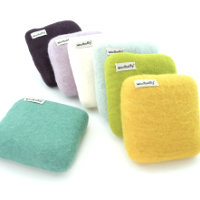 Woolbuddy Felting Mat Small – This is my go-to mat. It holds up well over time and it’s very portable. I use one side for light color wool and the other for dark. I also usually lay a piece of felt sheet over the top when working. That helps me lift the pieces off the mat and I think it makes the surface last a little longer.
Woolbuddy Felting Mat Small – This is my go-to mat. It holds up well over time and it’s very portable. I use one side for light color wool and the other for dark. I also usually lay a piece of felt sheet over the top when working. That helps me lift the pieces off the mat and I think it makes the surface last a little longer.
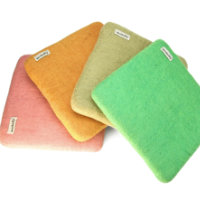 Woolbuddy Felting Mat Large – Same as the small size above but for larger projects
Woolbuddy Felting Mat Large – Same as the small size above but for larger projects
 Sarafina’s Mini Stabbit Wabbit Set – Fill these with dry rice or buckwheat and use them to felt between animal’s legs, to prop up a neck, and much more. I use both of them often.
Sarafina’s Mini Stabbit Wabbit Set – Fill these with dry rice or buckwheat and use them to felt between animal’s legs, to prop up a neck, and much more. I use both of them often.
 Foam Felting Mat – I prefer foam or a wool ironing mat for 2D (two dimensional) work or wool painting. The size I purchase depends on the size of the piece I’m making. I like to be able to fit the whole painting on the mat if possible.
Foam Felting Mat – I prefer foam or a wool ironing mat for 2D (two dimensional) work or wool painting. The size I purchase depends on the size of the piece I’m making. I like to be able to fit the whole painting on the mat if possible.
 Wool Pressing Mat – This 100% wool mat is much denser than the other mats above. It takes a little getting used to because it resists your needle. I love it for 2D (two dimensional) work or working with a mold (e.g., cookie cutter). I place a sheet of scrap felt on top of the pressing mat when felting. That makes it easy to lift and reposition my work.
Wool Pressing Mat – This 100% wool mat is much denser than the other mats above. It takes a little getting used to because it resists your needle. I love it for 2D (two dimensional) work or working with a mold (e.g., cookie cutter). I place a sheet of scrap felt on top of the pressing mat when felting. That makes it easy to lift and reposition my work.
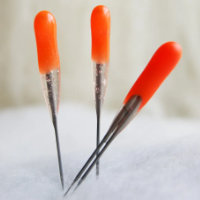 Felt Alive’s Orange Beginner Short Blade Felting Needles Combo Pack – While I love a regular needle in a nice holder, these orange needles are fantastic for general use. I always have one on my table. They’re sturdy and a workhorse. I tend to use the single needles more than the double. But the double is great for working on larger surfaces.
Felt Alive’s Orange Beginner Short Blade Felting Needles Combo Pack – While I love a regular needle in a nice holder, these orange needles are fantastic for general use. I always have one on my table. They’re sturdy and a workhorse. I tend to use the single needles more than the double. But the double is great for working on larger surfaces.
 Felting Needles 40 Twist/Spiral – This is my favorite needle for finishing a project. It works especially well to smooth your surface and is a must have when working with delicate, fine fibers.
Felting Needles 40 Twist/Spiral – This is my favorite needle for finishing a project. It works especially well to smooth your surface and is a must have when working with delicate, fine fibers.
 Felting Needles 38 Star – If I could only use one needle, a 38 star would be my choice. You can make entire pieces with this needle. I also appreciate the quality of Groz-Beckert needles. They grab the fiber well, don’t rust, and don’t bend as easily as less expensive needles. I’m a fan.
Felting Needles 38 Star – If I could only use one needle, a 38 star would be my choice. You can make entire pieces with this needle. I also appreciate the quality of Groz-Beckert needles. They grab the fiber well, don’t rust, and don’t bend as easily as less expensive needles. I’m a fan.
 Felting Needles 36 Star – Same as above but a coarser version. I use these when I’m working on larger pieces or animals with a thick core. They’re great for getting your initial shapes and structure done quickly and effectively. I find they last a long time also.
Felting Needles 36 Star – Same as above but a coarser version. I use these when I’m working on larger pieces or animals with a thick core. They’re great for getting your initial shapes and structure done quickly and effectively. I find they last a long time also.
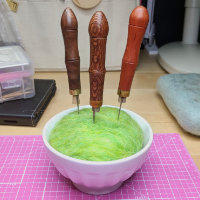 Needle Holders – I treasure my gorgeous wooden needle holders. They were handmade by Mab Graves‘ father. He tragically passed away so they are no longer made.
Needle Holders – I treasure my gorgeous wooden needle holders. They were handmade by Mab Graves‘ father. He tragically passed away so they are no longer made.
I have a red metal needle holder that is is sleek and futuristic. It works but I find it a little slippery. However aesthetically, the metal holder looks great on my worktable!
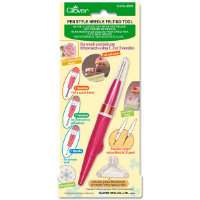 Clover Pen Style Needle Holder – This is a must have. I use it on almost every. It will hold 3 needles. I just keep 2 in it as that makes it great for felting a straight line. I also appreciate its plastic safety cap. I’ve had mine for five years and it’s still as good as the day I bought it.
Clover Pen Style Needle Holder – This is a must have. I use it on almost every. It will hold 3 needles. I just keep 2 in it as that makes it great for felting a straight line. I also appreciate its plastic safety cap. I’ve had mine for five years and it’s still as good as the day I bought it.
 Clover Needle Felting Punch Tool – This holds five needles and is great for felting a flat surface or making small sheets of felt to make ears or a pelt for a short haired animal. It’s another tool that I’ve had for five years and is still going strong. It also has a lock to keep the needles inside the plastic rim when you are not suing it. Great for safety and to protect the needles.
Clover Needle Felting Punch Tool – This holds five needles and is great for felting a flat surface or making small sheets of felt to make ears or a pelt for a short haired animal. It’s another tool that I’ve had for five years and is still going strong. It also has a lock to keep the needles inside the plastic rim when you are not suing it. Great for safety and to protect the needles.
 Needle holder/cushion – You need something to place your needles in when you are working. I keep mine in a sort of felting needle cushion I made out of wool and a small white ceramic bowl.
Needle holder/cushion – You need something to place your needles in when you are working. I keep mine in a sort of felting needle cushion I made out of wool and a small white ceramic bowl.
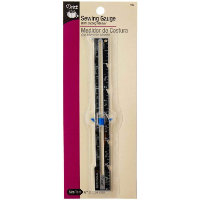 Dritz Sewing Gauge – A small ruler will work but I love the slider on this sewing gauge. I often just want to check that two ears or legs are the same length. This allows me to do that quickly without worrying about what the actual measurement is.
Dritz Sewing Gauge – A small ruler will work but I love the slider on this sewing gauge. I often just want to check that two ears or legs are the same length. This allows me to do that quickly without worrying about what the actual measurement is.
It also has inches and centimeters aligned (versus running in opposite directions like most rulers). That makes it easy to work with both or do quick conversions. It is one of my favorite tools.
 Westcott Clear Flexible Ruler – I use this ruler a lot. It doesn’t take up much space, won’t snap in half if you bump it, and is reasonably priced. I also like the vinyl sleeve it comes in. It helps keep the numbers from rubbing off when it’s stored.
Westcott Clear Flexible Ruler – I use this ruler a lot. It doesn’t take up much space, won’t snap in half if you bump it, and is reasonably priced. I also like the vinyl sleeve it comes in. It helps keep the numbers from rubbing off when it’s stored.
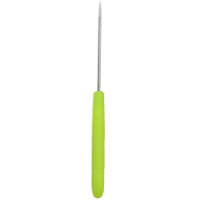 Small Awl – This is a must have. I use this small awl or pick on every project. It pokes holes, helps position top coat, picks out stray fibers, and so much more. This one came with an inexpensive needle felting starter kit (like this one).
Small Awl – This is a must have. I use this small awl or pick on every project. It pokes holes, helps position top coat, picks out stray fibers, and so much more. This one came with an inexpensive needle felting starter kit (like this one).
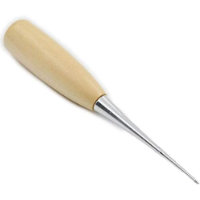 Awl With Wood Handle (Large) – I like this larger awl to poke wider holes for glass eyes or attaching limbs.
Awl With Wood Handle (Large) – I like this larger awl to poke wider holes for glass eyes or attaching limbs.
 Wire Flush Cutters – Basic wire cutters that work well on smaller, soft wire. I use them for craft wire, copper and aluminum.
Wire Flush Cutters – Basic wire cutters that work well on smaller, soft wire. I use them for craft wire, copper and aluminum.
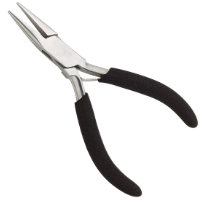 Chain Nose Pliers – all purpose pliers with a tapered tip that helps me shape and refine armatures
Chain Nose Pliers – all purpose pliers with a tapered tip that helps me shape and refine armatures
 Ball Head Pins – Useful for temporarily attaching limbs, ears, testing eye placement and much more. They are a must have.
Ball Head Pins – Useful for temporarily attaching limbs, ears, testing eye placement and much more. They are a must have.
 Short Stem Ball Head Pins – Wonderful to pinning ears or tiny pieces to small animals. I also use these to test the placement of eyes.
Short Stem Ball Head Pins – Wonderful to pinning ears or tiny pieces to small animals. I also use these to test the placement of eyes.
 Fiskars Micro-Tip Easy Action Shears – My go-to scissors. Easy on the hands, sharp, and amazing for getting into tight spaces. They are strong enough to cut away firmly felted areas that need to be reshaped. Use them only for fiber and they will stay sharp for a very long time.
Fiskars Micro-Tip Easy Action Shears – My go-to scissors. Easy on the hands, sharp, and amazing for getting into tight spaces. They are strong enough to cut away firmly felted areas that need to be reshaped. Use them only for fiber and they will stay sharp for a very long time.
 Gingher Embroidery Scissors – While these are a bit pricey, they are a great investment. I use them on every project. They’re the right size, sharp and they come with a leather sheath to protect them (and you) when not in use. I love these little scissors and feel they are worth every penny I spent on them. To keep them sharp, I never use them on anything but fiber or thin fabrics.
Gingher Embroidery Scissors – While these are a bit pricey, they are a great investment. I use them on every project. They’re the right size, sharp and they come with a leather sheath to protect them (and you) when not in use. I love these little scissors and feel they are worth every penny I spent on them. To keep them sharp, I never use them on anything but fiber or thin fabrics.
 Scotch All Purpose 8″ Scissors – Sometimes, I need a larger pair of scissors to cut things like felt sheet. I don’t use these on anything but fiber or fabric. That helps keep them sharp.
Scotch All Purpose 8″ Scissors – Sometimes, I need a larger pair of scissors to cut things like felt sheet. I don’t use these on anything but fiber or fabric. That helps keep them sharp.
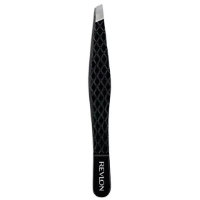 Revlon Stainless Steel Slant Tip Tweezers – The slanted tip makes it easy to grab stray fibers and get into small areas. While these are painted black, they are solid metal which means they’ll last a long time if you take care of them.
Revlon Stainless Steel Slant Tip Tweezers – The slanted tip makes it easy to grab stray fibers and get into small areas. While these are painted black, they are solid metal which means they’ll last a long time if you take care of them.
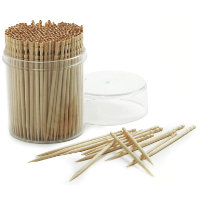 Round Wood Toothpicks in a Container – Round toothpicks help me put a tiny dab of glue in a tight space, pick wool or position fibers where I want them, and the pointed end can serve as a tiny beak in a pinch. I also love that they are in their own container. It makes it easy to store them without a mess.
Round Wood Toothpicks in a Container – Round toothpicks help me put a tiny dab of glue in a tight space, pick wool or position fibers where I want them, and the pointed end can serve as a tiny beak in a pinch. I also love that they are in their own container. It makes it easy to store them without a mess.
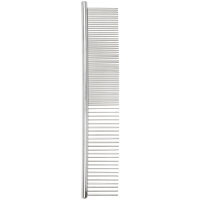 Metal Pet Comb – This is fantastic for combing out stray fibers after trimming a long haired needle felted animal. It’s also helpful for aligning fibers after you hand blend them if you’re mixing colors for long fur.
Metal Pet Comb – This is fantastic for combing out stray fibers after trimming a long haired needle felted animal. It’s also helpful for aligning fibers after you hand blend them if you’re mixing colors for long fur.
 Safari Self Cleaning Slicker Brush – I purchased two of these retractable dog brushes to use as hand carders. I love them because retracting the metal tines on the brush allows me to easily clean out the fiber. That way the next time I’m blending a color, I don’t get unexpected bits of the previous color mixed into my lovely new blend. I have the “Large” size which is 4 1/2 by 3 1/2″.
Safari Self Cleaning Slicker Brush – I purchased two of these retractable dog brushes to use as hand carders. I love them because retracting the metal tines on the brush allows me to easily clean out the fiber. That way the next time I’m blending a color, I don’t get unexpected bits of the previous color mixed into my lovely new blend. I have the “Large” size which is 4 1/2 by 3 1/2″.
 Glass Eye Test Set – These are sets of different size glass eyes on pins. I love the smaller set for testing the placement and size of eyes on my animals.
Glass Eye Test Set – These are sets of different size glass eyes on pins. I love the smaller set for testing the placement and size of eyes on my animals.
I purchased the larger size set also but I rarely use it.
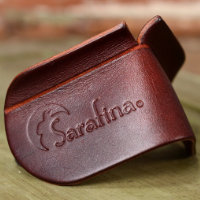 Sarafina Grab and Stab Finger Protector – This is such a simple tool but very effective at doing what it is meant to. I love it. I have used mine a lot so the interior is a little beat up. I just trim any stray pieces of leather to keep it like new.
Sarafina Grab and Stab Finger Protector – This is such a simple tool but very effective at doing what it is meant to. I love it. I have used mine a lot so the interior is a little beat up. I just trim any stray pieces of leather to keep it like new.
Optional tools I use regularly
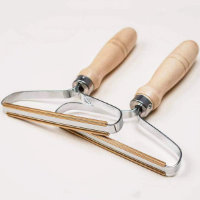 Lint Remover Wand with Wooden Handle – This is the best tool I’ve found to clean my Woolbuddy Felting Mats. It’s quick, effective, inexpensive, and fits right in my tabletop toolbag. Love it!
Lint Remover Wand with Wooden Handle – This is the best tool I’ve found to clean my Woolbuddy Felting Mats. It’s quick, effective, inexpensive, and fits right in my tabletop toolbag. Love it!
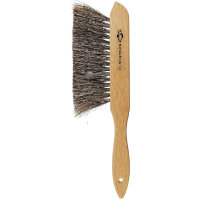 Alvin Draftsman’s Mini-Duster #2340 – I use this brush away fiber and trimmings from my work surface. Especially good after shaping long fur.
Alvin Draftsman’s Mini-Duster #2340 – I use this brush away fiber and trimmings from my work surface. Especially good after shaping long fur.
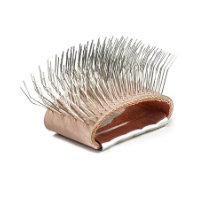 Bunka Brush – This is fabulous for pulling fibers up to create fuzzy fur on a felted sheet or a firmly felted surface. With a light touch, you can also use it to style long fur you’ve felted. Very useful little item.
Bunka Brush – This is fabulous for pulling fibers up to create fuzzy fur on a felted sheet or a firmly felted surface. With a light touch, you can also use it to style long fur you’ve felted. Very useful little item.
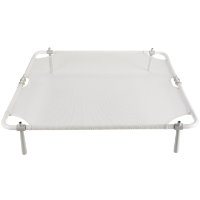 OXO Good Grips Folding Sweater Drying Rack – I use this sweater dryer to dry scoured raw fleece or locks, dyed wool, and wet felted pieces. I love that it folds up for storage in my closet. It is also easy to wash if needed. The quality is fantastic. I’ve had two for several years and they look brand new.
OXO Good Grips Folding Sweater Drying Rack – I use this sweater dryer to dry scoured raw fleece or locks, dyed wool, and wet felted pieces. I love that it folds up for storage in my closet. It is also easy to wash if needed. The quality is fantastic. I’ve had two for several years and they look brand new.
 Sarafina Digitwidget – This helps me make consistent toes and fingers. I especially love it for bird feet. Like other Sarafina tools, this is well made. I bought mine at least four years ago and it is still lovely.
Sarafina Digitwidget – This helps me make consistent toes and fingers. I especially love it for bird feet. Like other Sarafina tools, this is well made. I bought mine at least four years ago and it is still lovely.
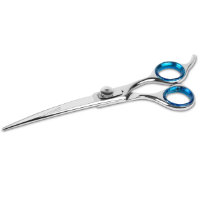 Curved Hair Trimming Scissors – I find that a curved pair of pet trimming scissors works better than straight scissors when trimming my needle felted animal fur. This pair feels comfortable and I can achieve nicer shapes, especially when trimming long fur or tails.
Curved Hair Trimming Scissors – I find that a curved pair of pet trimming scissors works better than straight scissors when trimming my needle felted animal fur. This pair feels comfortable and I can achieve nicer shapes, especially when trimming long fur or tails.
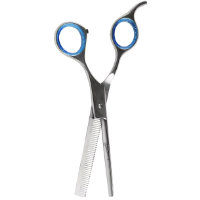 42 Teeth Thinning Scissors – If you purchase thinning shears, be sure to buy a pair with a good number of teeth. I originally bought a cheap pair with wide spaces between the teeth. It didn’t work well. These do a great job of blending the edges of long fur so it looks more natural instead of cut.
42 Teeth Thinning Scissors – If you purchase thinning shears, be sure to buy a pair with a good number of teeth. I originally bought a cheap pair with wide spaces between the teeth. It didn’t work well. These do a great job of blending the edges of long fur so it looks more natural instead of cut.
Specialty tools for things like making claws, using wax, paint, etc.
 Extra Long Doll Needle – I use this 5″ long, sturdy needle to attach limbs and to sew in thread hangers on animal ornaments. I also use the shorter length Doll Needle Assortment by Dritz. That is fantastic when what I need to attach doesn’t require the 5″ version.
Extra Long Doll Needle – I use this 5″ long, sturdy needle to attach limbs and to sew in thread hangers on animal ornaments. I also use the shorter length Doll Needle Assortment by Dritz. That is fantastic when what I need to attach doesn’t require the 5″ version.
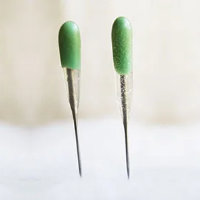 Felting Needles 40 Gauge Reverse – I like the handles on these Felt Alive reverse needles because I find that fine reverse needles tend to break easily. The chunky top helps me keep a firm grasp on the needle and pull it out straight. I use these to add small details or blend colors.
Felting Needles 40 Gauge Reverse – I like the handles on these Felt Alive reverse needles because I find that fine reverse needles tend to break easily. The chunky top helps me keep a firm grasp on the needle and pull it out straight. I use these to add small details or blend colors.
If you want to reverse felt fur, I’d recommend using a coarser needle to pull out long fibers. You might want to try Living Felt’s 38 Gauge Reverse Needle or 36 Gauge Reverse Needle instead of this 40.
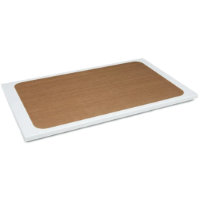 Cool Tools Clayboard Non-Stick Work Surface 6″ X 9″ – I use this for working with clay. It is sturdy, doesn’t grab the clay, and cleans up easily. The size also makes it easy to maneuver while you’re creating and to store.
Cool Tools Clayboard Non-Stick Work Surface 6″ X 9″ – I use this for working with clay. It is sturdy, doesn’t grab the clay, and cleans up easily. The size also makes it easy to maneuver while you’re creating and to store.
 Clay Shaper Set #0 By Craft Smart – Nice mini set for working on small pieces or getting into tiny areas. If you’re looking for larger size tools, the #2 set might work for you.
Clay Shaper Set #0 By Craft Smart – Nice mini set for working on small pieces or getting into tiny areas. If you’re looking for larger size tools, the #2 set might work for you.
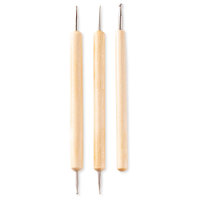 Ball Tipped Embossing Stylus Tools Set – I use this for clay and also for creating lines, texture, or smoothing small areas of wax
Ball Tipped Embossing Stylus Tools Set – I use this for clay and also for creating lines, texture, or smoothing small areas of wax
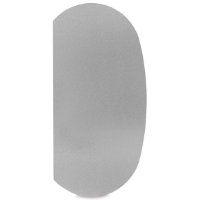 Steel Clay Scraper / Slicer – I use this tool to slice clay. It’s helpful and easy to clean.
Steel Clay Scraper / Slicer – I use this tool to slice clay. It’s helpful and easy to clean.
 Metal Needle Tool – This is an all purpose clay tool that I use to draw lines, create texture, and to add details.
Metal Needle Tool – This is an all purpose clay tool that I use to draw lines, create texture, and to add details.
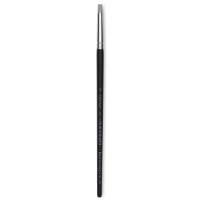 Colour Shapers Tool, Flat Chisel, Size 2 – I use this for applying wax or Swax to claws, beaks, and noses
Colour Shapers Tool, Flat Chisel, Size 2 – I use this for applying wax or Swax to claws, beaks, and noses
 Clover Large Needle Felting Brush Mat – I don’t use this a lot but I find it helpful for delicate or thin felted pieces like ears. I’ve started laying a piece of sheet felt over it to keep the fibers out of the brushes. There is also a small version.
Clover Large Needle Felting Brush Mat – I don’t use this a lot but I find it helpful for delicate or thin felted pieces like ears. I’ve started laying a piece of sheet felt over it to keep the fibers out of the brushes. There is also a small version.

